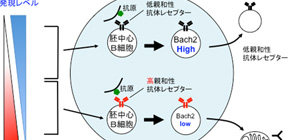
Mechanism for inducing memory B cell differentiation elucidated
Efficient induction of immune cells that remember antigens will lead to the development of new vaccines
A group of researchers led by Assistant Professor SHINNAKASU Ryou and Professor KUROSAKI Tomohiro (WPI Immunology Frontier Research Center, Osaka University) and a group of researchers led by Team Leader OKADA Takaharu (Laboratory for Tissue Dynamics, RIKEN Center for Integrative Medical Sciences) jointly clarified the unknown mechanism for inducing germinal-center B cells’ differentiation into memory B cells, immune cells that remember antigens, at the molecular level.
When re-exposed to antigens such as bacteria or viruses, our bodies get rid of antigens by producing more antibodies than in the primary response. This is because memory B cells, which remember antigens in the primary immune response, are induced and respond faster in the secondary exposure to bacteria or viruses and differentiate into antibody-producing cells.
Vaccines block virus entry by making good use of such responses. When antigens such as viruses and vaccines enter the human body, germinal centers are produced within secondary lymph nodes and memory B cells are then induced from germinal-center B cells. However, the mechanism behind the induction was not yet understood, and the clarification of this mechanism has been an important research agenda.
This group clarified that germinal-center B cells with lower affinity maturation of antigens were easily differentiation-induced into memory B cells. This group also found that the expression level of transcription factor Bach2 in germinal-center B cells with lower affinity was significantly high and that this high expression of Bach2 was important for memory B cell differentiation.
This group’s achievement reverses the conventional wisdom that memory B cells are induced by high-affinity cells, possibly greatly influencing vaccine strategies targeting memory B cells. Bach2, an important gene for inducing memory B cells, may become an important target in vaccine strategies.
Abstract
Despite the importance of memory B cells in protection from reinfection, how such memory cells are selected and generated during germinal-center (GC) reactions remains unclear. We found here that light-zone (LZ) GC B cells with B cell antigen receptors (BCRs) of lower affinity were prone to enter the memory B cell pool. Mechanistically, cells in this memory-prone fraction had higher expression of the transcriptional repressor Bach2 than that of their counterparts with BCRs of higher affinity. Haploinsufficiency of Bach2 resulted in reduced generation of memory B cells, independently of suppression of the gene encoding the transcription factor Blimp-1. Bach2 expression in GC cells was inversely correlated with the strength of help provided by T cells. Thus, we propose an instructive model in which weak help from T cells maintains relatively high expression of Bach2, which predisposes GC cells to enter the memory pool.

M echanism of selection of memory B cells and plasma cells from germinal center B cells
The affinity of B cell receptor for antigen and the expression level of Bach2 are inversely correlated in germinal center B cells. Low affinity germinal center B cells, which receive weaker stimulation from antigen and antigen specific CD4 T cells, maintain a relatively high level of Bach2 expression and tend to be induced to form memory B cells in the germinal center. On the other hand, high affinity cells, which receive strong stimulation from antigen and antigen specific CD4 T cells, have difficulty maintaining Bach2 expression at high levels and tend to be induced to form plasmablasts (plasma cells).
To learn more about this research, please view the full research report entitled " Regulated selection of germinal center cells into the memory B cell compartment " at this page of the Nature Immunology website.
Related link
